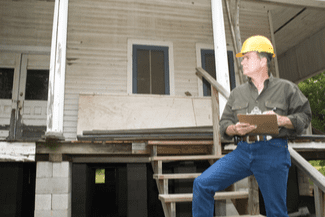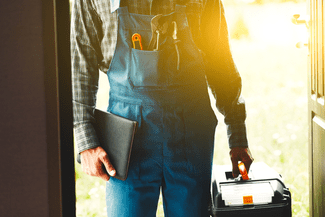What Apartment Owners Need to Know About SB-721

Here at Deck and Balcony Inspections, Inc., we inspect California balconies, decks, and walkways every week and understand the extensive compliance requirements of SB-721.
In this blog, we outline everything you need to know about this law and what you need to do before the January 1, 2025 deadline.
Let’s dive in.
What Led SB-721 to be Passed?
SB-721 was passed in response to a tragic balcony collapse in Berkeley, California. The event took place at a student housing facility and killed six college students.
In response to the tragedy, an investigation was launched to determine the cause. The investigation uncovered three key things:
- The balcony failure was caused by dry rot.
- The balcony had not been inspected by trained personnel.
- The balcony failure was 100% avoidable.
These findings compelled the California senate to draft and pass the new bill.

What are the Requirements of SB-721?
Here are the key takeaways:
- Mandatory Safety Inspections. Every apartment facility with decks, balconies, entries, or walkways elevated more than 6” must have safety inspections performed before January 1, 2025.
- Qualified Safety Inspectors. All balcony inspections must be performed by personnel who are qualified to do so under the provisions of SB-721. Qualified parties include general contractors licensed in the state of California, certified building inspectors, and architects or engineers. It is important to note that the person who performs the inspection cannot be the same person who completes any needed repairs.
- Recurring Inspection Safety inspections must reoccur every six years and be completed by qualified safety inspectors. A minimum of 15% of each type of elevated element must be inspected each time. The inspector can choose which elevated features to examine.
- Documented Inspection Reports. Safety inspection reports must be kept for two inspection cycles or (a total of 12 years). Furthermore, the inspection reports must be made available for jurisdictional officials upon request.
- Penalties. Under the new bill, penalties of $100-$500 per day will be assessed for non-compliant facilities. If a civil fine or penalty has been assessed, the local jurisdiction also reserves the right to enforce a safety lien against the facility. If a building owner refuses to pay the fines issued against them, the local jurisdiction can seek to satisfy the lien through foreclosure.
- Impacts on the landlord’s insurance. If a facility falls into non-compliance, it may affect the building or landlord’s eligibility for insurance.
SB-721 Reporting Requirements
Under SB-721, safety inspection reports have three primary requirements. These are as follows:
- The inspection report must clearly define the condition of the elevated exterior element. The report must provide enough information so that the person reviewing the report can make informed decisions regarding the next steps.
- The report must clarify expectations regarding the projected service life of the elevated element. This can be difficult, as the life expectancy of any exterior wood-framed feature is wholly dependent on the frequency and quality of needed maintenance duties.
- The report must make recommendations for additional inspections if needed. Additionally, the law allows inspectors to order further inspections based on their preliminary findings.
The inspection company must deliver a full report that satisfies these three main requirements within 45 days of the inspection.
What If Repairs are Required?
If the inspection report reveals that repairs are needed, the inspector must classify the findings under one of two categories.
These categories are as follows:
Immediate Action Required
These issues represent a risk to life and safety. Examples include a loose deck rail that would break if a person were to lean against it or extensive dry rot that compromises the structural integrity or stability of a balcony.
If the safety inspection reveals issues that require immediate action, the inspector must notify the building owner and local building department within 15 days of the inspection. The owner must then inform the effective tenant and secure the area if needed to prevent access.
If repairs are not completed within 180 days, the inspector will issue a 30-day warning to the property owner and local building day apartment. If 30 days expires and the needed repairs are still not complete, a safety lien will be filed against the property and daily penalties will be assessed.
Repairs Required
These issues include anything that cannot be cured by maintenance but does not currently represent a threat to safety. An example could be the beginning stages of dry rot in a deck rail.
If an inspection reveals that repairs are required, the owner has 120 days to obtain a building permit for the needed repairs and an additional 120 days to make the necessary repairs after the permit is issued.
If the repairs are not complete within 180 days, the inspector will issue a 30-day warning and notify local law enforcement. If 30 days pass and the repairs are still incomplete, a safety lien is filed, and daily penalties are assessed.
Why Choose Us to Perform Your SB-721 Inspection?
Here at Deck and Balcony Inspections, Inc., we pride ourselves on using state-of-the-art technology to provide comprehensive inspection services that help you comply with the requirements of SB-721.
Here are just a few of the reasons apartment owners choose our team:
- Industry Experience. Owner Daniel Cronk has more than 40 years of experience in the construction industry, as both a certified structural inspector and general contractor.
- Non-invasive inspections. When we perform deck and balcony inspections, we go the extra mile to be thorough, precise, and non-invasive. Our proprietary process allows us to avoid destructive testing by using endoscopes to evaluate the internal structure of your balcony – without creating additional expenses for you.
- Intelligent software integration. We use cutting-edge software that integrates with moisture sensors and allows us to determine whether moisture – the leading cause of destructive, dangerous balcony dry rot – has penetrated the exterior coatings of your balcony.
- Comprehensive reporting. After each inspection, we provide an easy-to-read, interactive online report complete with color-coded breakdowns that prioritize needed repairs based on urgency.
- Affordable reinspection. Get off the hamster wheel of compliance and stop paying hefty reinspection fees every six years. When you develop a long-term relationship with our team, your interactive safety reports can easily be updated to include new findings and save you money on subsequent inspections.
Don’t Wait Until the Last Minute! Schedule Your SB-721 Inspection Today

Unfortunately, that’s simply not true.
At the time of this writing, there are nearly 500,000 apartment facilities in California, but only 200 building inspectors qualified to perform SB-721 inspections.
At that ratio, each inspector would need to complete more than 800 inspections per year to fulfill the impending need, which simply isn’t possible.
As such, we recommend you lock in your inspection dates sooner rather than later.
Fortunately, our team is here for you.
Keep your tenants and employees safe and enjoy the peace of mind that comes with knowing your facilities are compliant and structurally sound.
Contact us today for a FREE SB-721 inspection quote: 916-238-0618















 Accessibility
Accessibility